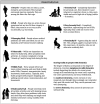Role of frailty assessment in patients undergoing cardiac interventions
- PMID: 25332792
- PMCID: PMC4195918
- DOI: 10.1136/openhrt-2013-000033
Role of frailty assessment in patients undergoing cardiac interventions
Abstract
Average life expectancy is increasing in the western world resulting in a growing number of frail individuals with coronary heart disease, often associated with comorbidities. Decisions to proceed to invasive interventions in elderly frail patients is challenging because they may gain benefit, but are also at risk of procedure-related complications. Current risk scores designed to predict mortality in cardiac procedures are mainly based on clinical and angiographic factors, with limitations in the elderly because they are mainly derived from a middle-aged population, do not account for frailty and do not predict the impact of the procedure on quality of life which often matters more to elderly patients than mortality. Frailty assessment has emerged as a measure of biological age that correlates well with quality of life, hospital admissions and mortality. Potentially, the incorporation of frailty into current risk assessment models will cause a shift towards more appropriate care. The need for a more accurate method of risk stratification incorporating frailty, particularly for elderly patients is pressing. This article reviews the association between frailty and cardiovascular disease, the impact of frailty on outcomes of cardiac interventions and suggests ways in which frailty assessment could be incorporated into cardiology clinical practice.
Figures
References
-
- Song X, Mitnitski A, Rockwood K. Prevalence and 10-year outcomes of frailty in older adults in relation to deficit accumulation. J Am Geriatr Soc 2010;58:681–7 - PubMed
-
- Carlson JE, Zocchi KA, Bettencourt DM, et al. Measuring frailty in the hospitalized elderly: concept of functional homeostasis. Am J Phys Med Rehabil 1998;77:252–7 - PubMed
Grants and funding
LinkOut - more resources
Full Text Sources
Other Literature Sources
Medical



